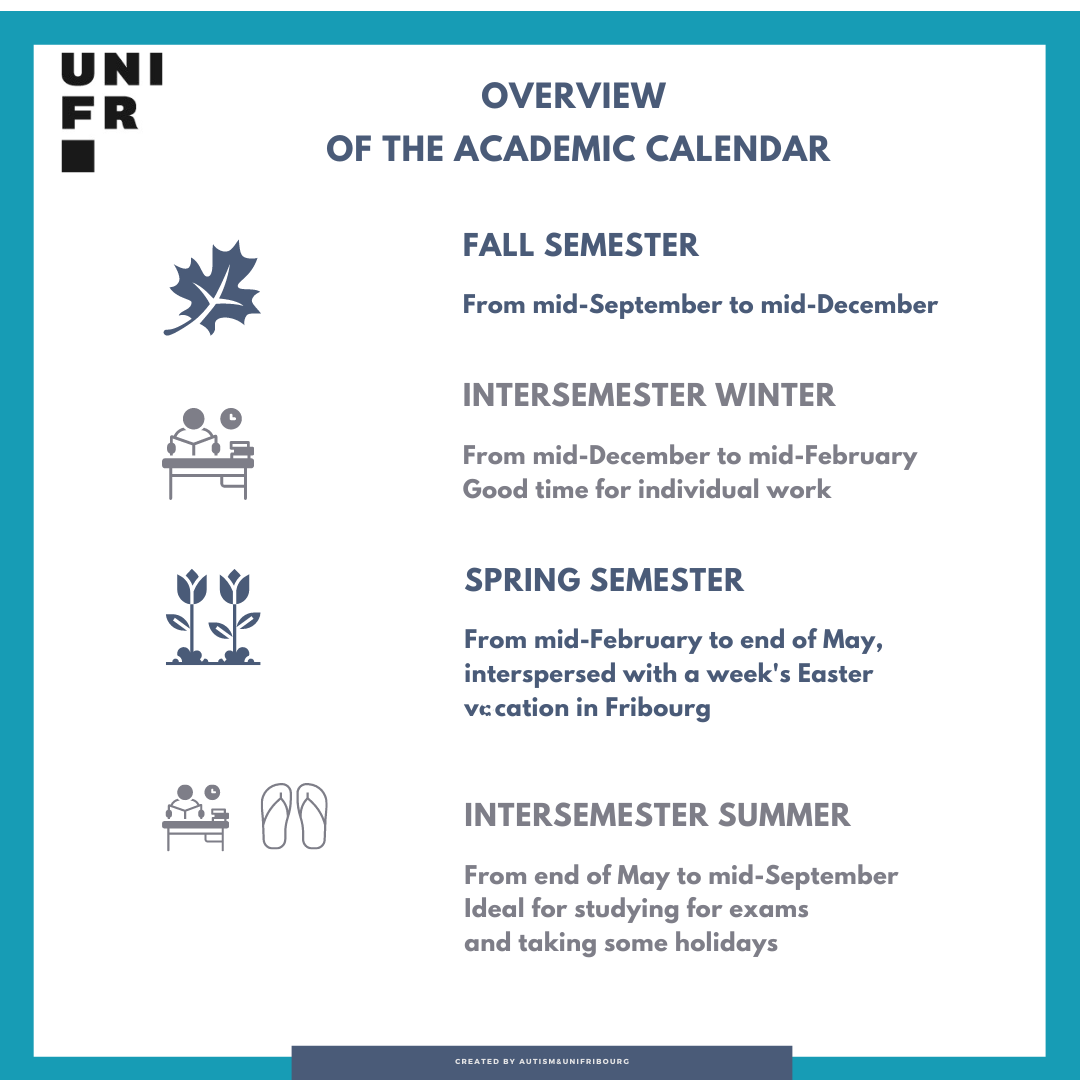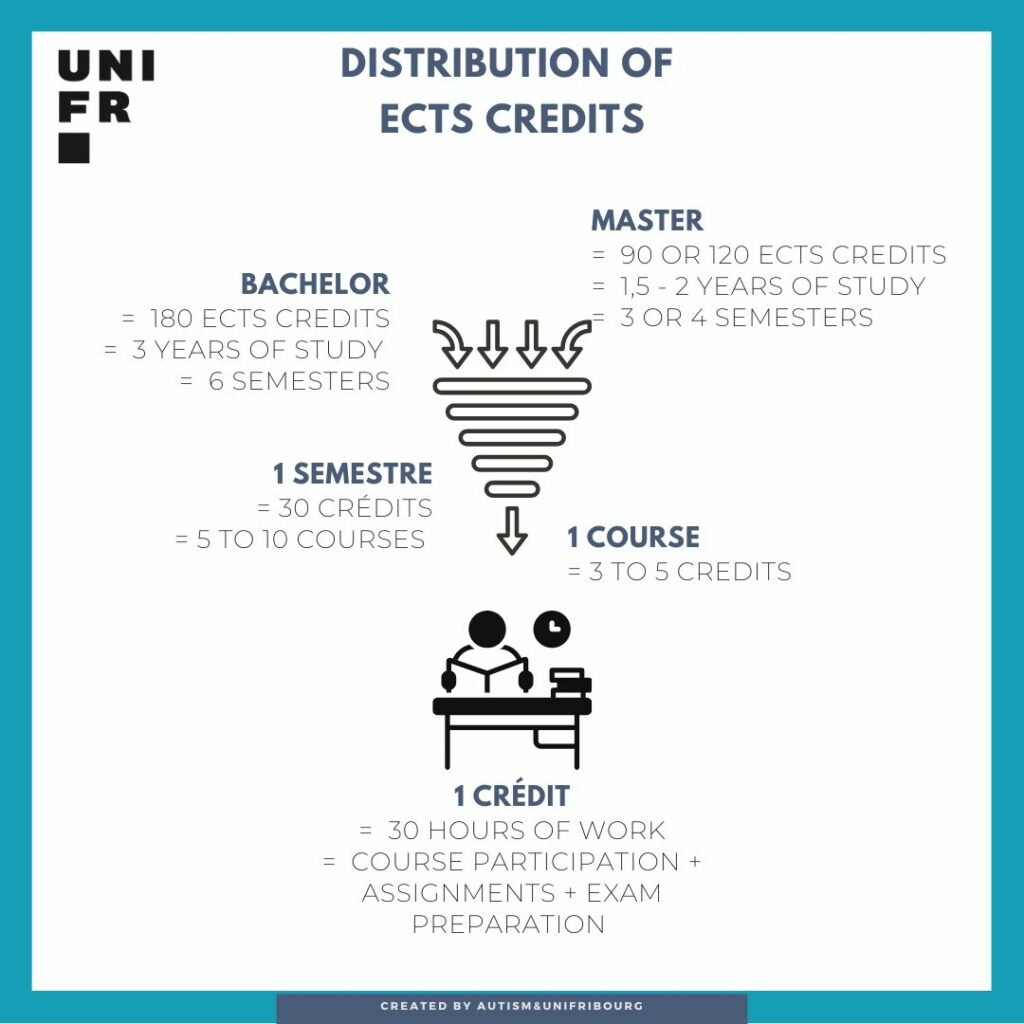This chapter contains information about how studying and courses are organized at the University. You will better understand the intricacies of the academic calendar and how to find useful information.
Context
University calendar
An academic year is divided into two semesters, the autumn semester (often abbreviated to SA) and the spring semester (often abbreviated to SP). The dates of the semesters, holidays and other important dates can be found in the academic calendar of the University of Fribourg. Some faculties add dates common to all students to this calendar, for example the registration deadlines for courses and exams.
The SA begins around mid-September and ends around mid-December.
The SP starts around mid-February and ends around mid-June.
In Fribourg, there is a week off at Easter (usually in April).
Between these two semesters are the “inter-semesters” during which there are no classes. These periods without classes can seem long, but they are often necessary to prepare for exams and to submit assignments.
When you choose a program of study, you will receive a study plan. If you do not receive it, you can find it online on the page of the department that concerns you. If it is not there, you can contact your department or faculty advisor who will tell you where to find it.
ECTS credits
Almost all courses end with examinations and are validated by ECTS credits. For a Bachelor’s degree in Switzerland, 180 ECTS credits are required, which in principle means three years of full-time study (or six semesters).
The Master’s degree is considered the second cycle of higher education and corresponds to the acquisition of 90 ECTS credits, i.e., one and a half years of full-time study (or 3 semesters) in addition to the Bachelor’s degree. In some fields of study, the Master’s degree is worth 120 ECTS credits, i.e., four full-time semesters.
Each department is organized independently. Thus, there are big differences between the different study programs. Often, there are 60 ECTS credits to validate each year when studying full-time. These credits are obtained by successfully passing the exams for each course. There is often a structure of 5 to 10 courses per semester, each worth 3 to 5 credits. However, these numbers do not apply to all programs of study.
Furthermore, it is estimated that each credit is worth about 30 hours of work, including course participation, assignments and exam preparation.
Students are encouraged to complete their studies within the planned time frame of their course, but each student is free to arrange his or her studies as he or she sees fit, while respecting the guidelines and regulations. For example, it is often permissible to enrol in some courses and not to enrol in others. This adds to the length of the course and the complexity of social life, but it is possible for students who wish to concentrate on fewer courses at a time. At all times, students are encouraged to speak to their academic advisor to ensure that they do not make mistakes in their planning or take too many semesters to finish their degree.
Course lengths: When you get your study plan, you will see that there are different types of courses: some courses are annual, so they start in September and end in June. Other courses are semester courses, which means that they only run for the duration of the autumn semester or only for the duration of the spring semester.
Pace and format of courses: You will find full details in the chapter Understanding course and exam types.
The validation of the course is often done during a written or oral exam but can also take place in the form of work to be handed in or presented. Validation can take place during the last course (so-called “integrated” evaluation), or during the examination session. This validation is done either according to a mark system (between 1 and 6), or according to a pass/fail validation. In rare cases, validation of the course is given when a majority of the classes are attended.
When you first look at a curriculum, the organization seems complicated. But if you take the time to read the different pieces of information one by one, everything becomes more understandable. A good way to get a better understanding of the curriculum is to go and look up the courses in your syllabus one by one on Timetable. This platform will inform you about the type of courses, exams, dates, and the rooms where the courses are given.
Registration is often a source of stress for students. Indeed, each course requires a double registration: the registration to the course (this one is often called teaching unit or UE), and the registration for the exam of this course. All registrations are done through your personal platform Myunifr. This platform is very important because it informs you of the deadlines not to be missed. You will also find the deadlines for deregistration. It is a good idea to read the guidelines and regulations of your course of study in order to understand the deadlines for possible deregistration from the exams if you do not feel ready.
What does that have to do with me?
The University gives students a lot of freedom. The challenge with this freedom is to find an efficient system to organize yourself and achieve the goals you have set for yourself. There are as many systems as there are students! You just have to find the one that works best for you.
The rhythm at university alternates between classes, individual study and time to relax alone or with friends. You will find some tips on how to get organized in the Learning Strategies section.
What is the next step?
Search for all your courses in the course catalogue to note the rooms and dates of courses and exams in your calendar.
Practical advice
- Familiarize yourself with the registration system in your Myunifr
- Check that you are registered for the courses (teaching units) AND for the course exam
- Check the guidelines and regulations for course withdrawal deadlines
- Find all your courses in Timetable
- Define your organizational and crediting objectives
- Find an organization system that suits you (diary) and note down all the important places (classrooms), all the important dates (courses, exam dates, registration dates for courses and exams, deadlines, private appointments) as well as the distribution of individual work to be done outside of class hours
- Choose the place that suits you best for your individual study time (see also chapter on quiet libraries).
- If you have questions about the content or the investment required for certain courses, contact your academic advisor.
- If you have any questions about the disability compensation measures available to you, contact the Studies and Disability Office.
Questions to ask yourself
- Have you decided to follow the standard program?
- Do you understand how Myunifr works?
- Have you tested Timetable?
- Did you understand your teachers’ expectations for the exams?
- Do you feel that you have control over the amount of individual work you need to invest in order to pass your exams?
- Have you spoken to the academic advisor and made a personal schedule for getting credits?
- Are you in contact with other students in your program to discuss your respective issues, for example on a WhatsApp group?
- Have you found a work rhythm that is efficient and suits you?
Additional information
About the author
Edited by: Nathalie Quartenoud ©
Translated by: Daniel Dukes


 Back
Back 
